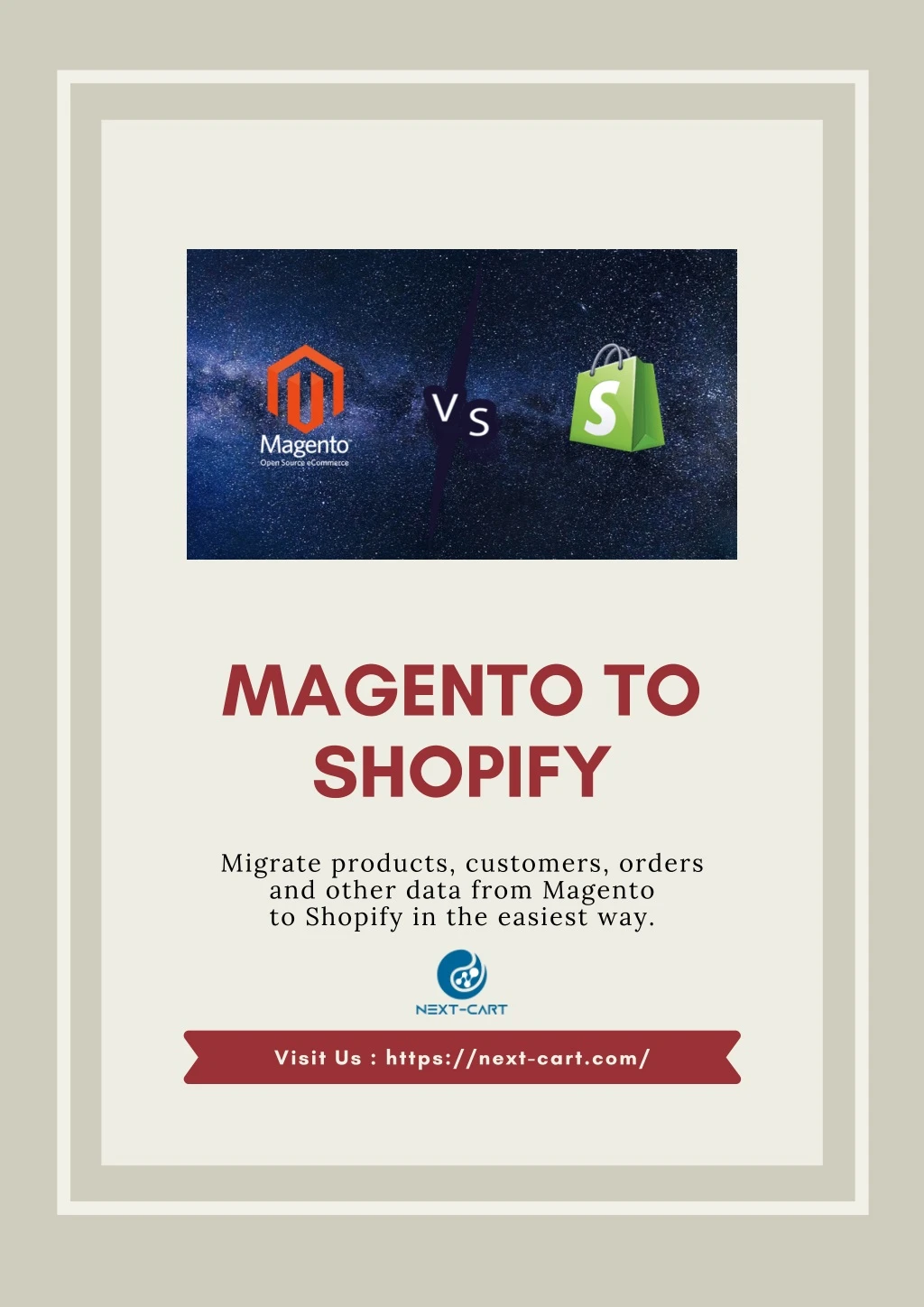Magento to Shopify or Shopify Plus SEO Friendly Migration: Detailed Guide for Small to Large Retailers
1. Planning on switching to Shopify? Would like to see how Shopify back-end looks? Click this image for free Shopify trial: https://www.shopify.com/?ref=adex-labs Many retailers wish to migrate the website to Shopify, but they are afraid of losing traffic so the business after migration. This post covers the complete & step by step migration re-platforming/re-branding guidelines/checklist for your web store. Source Platforms: Magento, Yahoo, Woo-commerce, Bigcommerce, CS-Cart, Cubecart, Drupal Commerce, IBM WebSphere Commerce, Netsuite, OpenCart, PrestaShop, Shopware, Volusion, X-Cart, Yahoo! E-commerce, Zen Cart, nopCommerce, osCommerce, Spree or any other. This guide is applicable to all platforms. © Adex Labs 2018 | adexlabs.com 2. Why Shopify? If you would like to get the most out of your e-commerce business, only think about Shopify. Below are some features which make this platform more robust: Built-in Speed & Security SEO friendly & options for SEO in the backend Abandoned cart recovery feature Free SSL certificate Fraud analysis Scalable platform Professional reports, Advanced Analysis No need to update CMS or extension/plugin Includes blogging platform Ample amount of available extensions/apps and many other features… © Adex Labs 2018 | adexlabs.com 3. Table Of Content Pre-Launch Migration Checklist ◠Rebranding Overview ◠Download the website for browsing anytime after migration ◠Collect Website URLs ◠Data Migration – Products, Categories, Orders, Customers, Stock, etc. ◠Update internal links ◠SEO friendly theme structure ◠SEO Tags ◠Canonical URL strategy ◠Your page title and meta description strategy ◠Site speed ◠301 URL Redirects -Simple URLs & Complex URLs ◠Make a custom 404 page ◠Google Search Console for the old site ◠Juice from 404 links – see 404 URL in webmaster tools © Adex Labs 2018 | adexlabs.com 4. While Migration ◠Make a New Site Ready for Google Search Console ◠Rebranding – Submit a change of address ◠Ensure that Google Analytics or other tracking applications are collecting data ◠Annotate the launch in Google Analytics and other analytics programs ◠Test URL redirects ◠Submit XML Sitemap Post-Launch Migration Checklist ◠Increase Crawl Rate ◠Monitor errors ◠Check the number of indexed pages © Adex Labs 2018 | adexlabs.com 5. Rebranding Overview Most of the people are afraid of rebranding due to the thought that they may lose traffic due to rebranding. But this is not a case always. How to carry out steps for this is explained in next points. Download the website for browsing anytime after migration While leaving old host or platform, you may need an old website to compare with a new site in future. For this purpose, you will have to download the website. Everything will remain in your local computer & you will be able to check the website anytime. To download the website, you can use the tool called HTTrack Website Copier. Collect Website URLs URL redirects are the most important factor to retain website traffic even after migration. So, make sure to collect a list of website URLs. You can use Use Screaming Frog or Xenu to crawl the website & collect the list of URLs. © Adex Labs 2018 | adexlabs.com 6. Data Migration – Products, Categories, Orders, Customers, Stock, etc. You may have to migrate Products, Categories, Historical orders, Customers, Stock, Gift cards, certificates, store credits, Blogs, Pages (shipping policy, contact, and other web pages), Product reviews. There are some paid apps available for automated migration. Migration can be done using CSV files as well. You can use CSV file for Products, Customer migration but not other things. Update internal links When you have old website links within the content of the website, it’s a better idea to replace with new links. This step is important if you have so many internal links otherwise you can ignore this as redirects can handle everything. Also, make sure that the link doesn’t go to non-existing links which can create 404 issue. © Adex Labs 2018 | adexlabs.com 7. SEO friendly theme structure SEO Tags Make sure to have the theme SEO friendly. Below are some notes to make the theme SEO friendly. Every Page must have the h1 tag & there shouldn’t be more than one h1 tag in a webpage. Product title on the product page, Blog title on blog post page, Page title on Pages should be in H1. Product Names on Collection page or product collections on other pages should have product titles in h2 Other subheadings should be in h2, h3, h4. Canonical URL strategy If some pages are also accessible using more that one URL, it’s better to notify search engines using the canonical tag to avoid duplicate content penalty. Shopify support URL canonicalization. Make sure to have code in your theme to handle canonical URLs. © Adex Labs 2018 | adexlabs.com 8. So, SEO Tags & Canonical URL strategy are important for SEO friendly theme structure. Your page title and meta description strategy If you have optimized title & meta description tags on the old website, make sure to migrate them. If you leave these two tags blank, Shopify will use product names as title tags & description as meta descriptions. For other pages, title tags will be page title & meta tag will be descriptions. Site speed In most of the cases, Shopify sites are fast & you can skip further optimization of website speed if your website loads within five seconds. You can use the following tools to see suggestions for speed optimization: 1) PageSpeed Insights – Google Developers 2) Pingdom Website Speed Test 3) GTmetrix © Adex Labs 2018 | adexlabs.com 9. 301 URL Redirects While working on 301 redirects, you will have to deal with two types of URLs. 1) Simple URLs E.g. example.com/navy-blue-t-shirt example.com/shipping-policy Shopify 301 URL Redirects © Adex Labs 2018 | adexlabs.com 10. This is how URL redirects work. 2) Complex or Pattern-based URLs E.g. example.com/tshirts-category?page=1 example.com/tshirts-category?page=2 Let’s consider that the destination URL is example.com/collection/tshirts-category You don’t need to worry about all variations of source URLs. Just use example.com/tshirts-category in old path & all URLs will be handled automatically with redirection as well as canonical URLs. Make a custom 404 page Don’t get hurt with a bad 404 page but use 404 page to boost your SEO. Create a custom 404 page with a branded design & website navigation options. Navigation options will keep customers stick to the site without leaving immediately. © Adex Labs 2018 | adexlabs.com 11. Google Search Console for Old site If you don’t have Google search console for the old site, make sure to install it. Juice from 404 links Uses Google Search Console to see if there is any URL any important 404 URL which has backlinks & pointing to 404 page. While Migration Make a New Site Ready for Google Search Console Make sure to have the new store verified in Google console to track data flawlessly even after migration. © Adex Labs 2018 | adexlabs.com 12. Rebranding – Submit a change of address Please ignore this step if you are not looking for rebranding. If you are looking for rebranding or changing domain after migration, don’t forget to add the new website to the Google console account. Now, open old domain in Google console account & make sure to notify Google regarding address change. Change of Address Google Search Console © Adex Labs 2018 | adexlabs.com 13. This step suggests Google that you are looking for re-branding & SEO juice can be retained even after domain change. It can take up to 180 days for Google to complete the change of address process. During this period, website traffic can drop. Google Analytics Tracking Review Ensure that Google Analytics or any other visitor tracking tool is tracking data correctly for the new website. You can use the same or different analytics account for the new domain. Annotate the launch in Google Analytics and other analytics programs If you are going to use the same Google Analytics account, make sure to annotate which can help you remember migration date. Test URL redirects Make sure one more time that the URL redirects are working properly. © Adex Labs 2018 | adexlabs.com 14. Submit XML Sitemap Make sure to submit the sitemap to Google & Bing console. For your Shopify site, you can find the sitemap URL at /sitemap.xml If your domain name is yourdomain.com, get the sitemap at yourdomain.com/sitemap.xml Post-Launch Migration Checklist Increase Crawl Rate After migration, make sure to increase crawl rate from Google Search Console. Increasing the crawl rate can help search engine index new URL faster & new data can be updated more frequently. Monitor errors Schedule error monitoring on daily basis or 2-3 times a week. You can monitor 404 errors in Google Search Console. © Adex Labs 2018 | adexlabs.com 15. Check the number of indexed pages Check the number of indexed pages in the search engine and google console. You can use site:yourdomain.com search query to see the number of indexed pages. © Adex Labs 2018 | adexlabs.com
183 views • 16 slides


